Summary of the Soviet space exploration, types of rockets and the most significant victories in this field. Part 2
 Bashny.Net
Bashny.Net
Good day, my dear reader, I continue my narrative of carrier rockets of the USSR and most interesting goods which they brought into space.
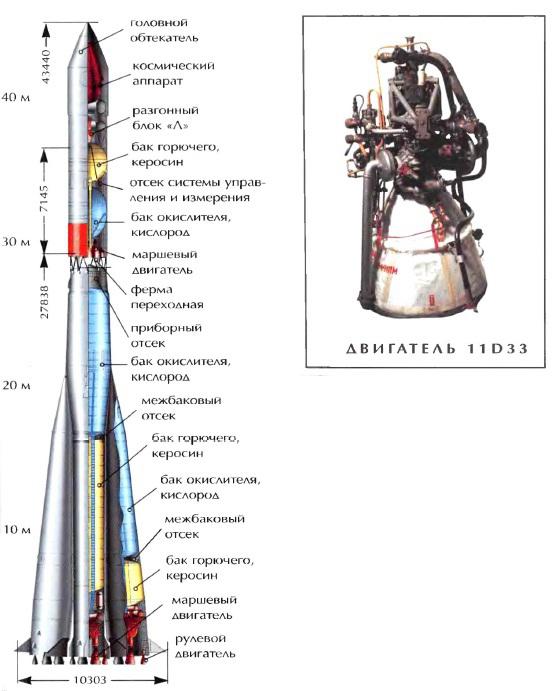
Booster "Lightning»
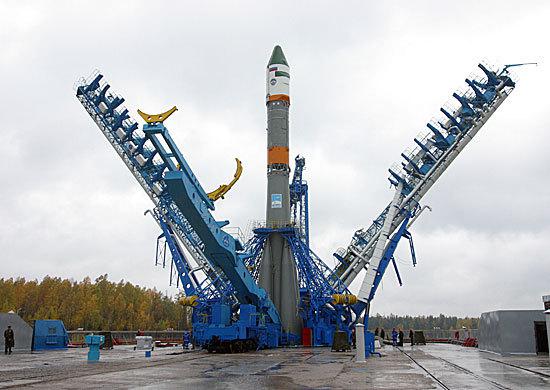
A modified version of the launcher "Molniya-M»
As is known in the solar system has eight planets. This is Mercury, Venus, Earth, Mars, Jupiter, Saturn, Uranus and Neptune. Previously thought planet of the solar system, Pluto now excluded from this "honorable" series. According to the degree of remoteness from the Sun, the Earth is the third. The closest planet to the Sun - it's Mercury, and the most distant - Neptune.
The shortest distance from these planets to Earth following (in millions. Km):
Mercury - 91.6
Venus - 41.4 is the closest planet to Earth.
Mars - 78.3
Jupiter - 628.4
Saturn - 1277.4
Uranus - 2721.4
Neptune - 4347.4
The information we will need later, for understanding, global steps, made the USSR during the space race.
Booster "Lightning" 8K78. The first launch of October 10, 1960. And its modifications "Molniya-M" 8K78M first launch on April 2 1964.
Develop to launch interplanetary spacecraft to Venus and Mars, and then - to run a series of lunar vehicles E-6 and E-6C ("Luna 4" - "Luna-14") has received prominence in connection with the launch of the satellite communications "Lightning" into high orbit.
With the help of these devices has been solved the problem of long-distance telephone and telegraph communications and relay transmission CCTV programming.
Later used to launch satellites Early-warning radar (EWS) "Eye».
It is noteworthy that this booster is one of the most successful. Who started it based missile carriers Union. Separately, you can say about satellites "Moon" which she launched into space. Of the 10 satellites, only 5 have coped with their tasks. I would particularly like to note the "Luna-9" and "Luna 13»
"Luna-9" the world's first soft-landed on the lunar surface in the Ocean of Storms, west of Reiner crater and Marius, at coordinates 64 degrees 22 minutes west longitude and 7 degrees 8 minutes north latitude. Station were held 7 sessions a total duration of more than 8 hours. During these sessions, AMC aired a panoramic image of the lunar surface near the landing site.
"Luna-9" has worked for 7 days and transferred to the ground three-photo panorama of the lunar surface. In addition, the station was equipped with gruntomerom-penetrometer radionuclear densitometer and dynamograph by which conducted the first in the history of instrumental study of the density and strength of the surface layer of lunar soil
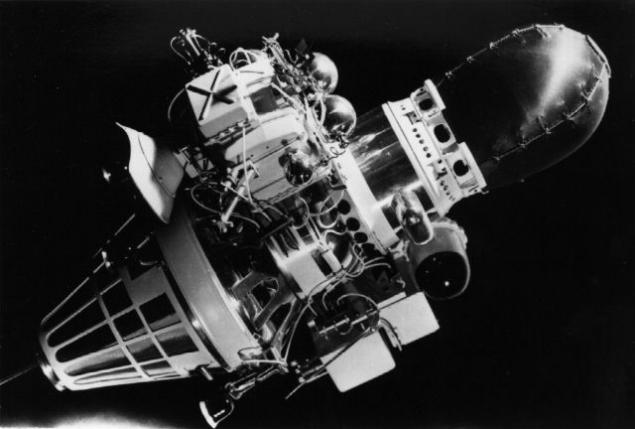
"Luna-9»

"Luna-9" from the lander.
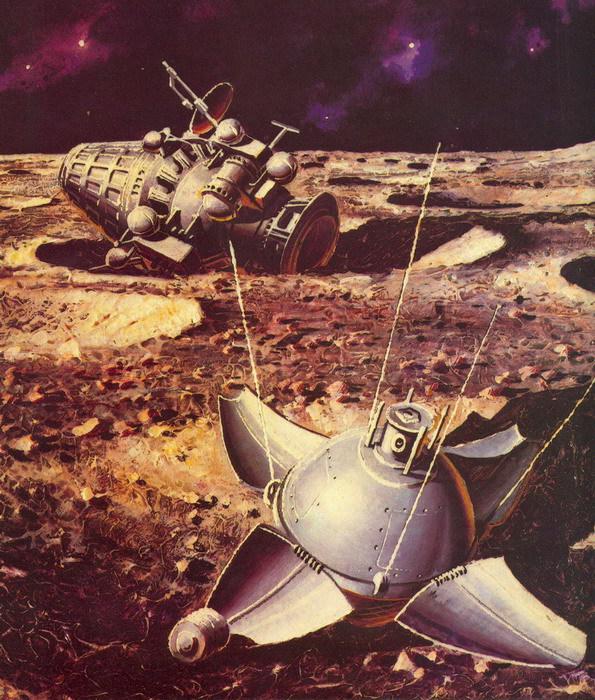
Figure descent module "Luna-9" on the background of its orbital module
The rest of the "Luna - 10, 11, 12, 14 'is not landed on our natural satellite, and the measurements made near-moon space.

"Luna-10»
Also on these carrier rockets were launched satellites "Mars" and "Venus". USSR championship vomited again in the US, but now it was a satellite launch to other planets.
Mars 1 - automatic interplanetary station Mars second generation program. One of the three AMC series M-62. The spacecraft was intended for research of Mars-flight trajectory, transmitting information about interplanetary space and the space around Mars. The first spacecraft to fly to Mars - "Mars-1" was created in OKB SP Korolev and launched in 1962, but has not reached the planet.

AMC "Mars-1" model.
"Venus-1" - automatic interplanetary station for investigation of the planet Venus. "Venus-1" was the first spacecraft flown 100 000 km from the planet Venus. At different stages of startup sometimes referred to as "heavy satellite 02" or "Satellite-8". From the station "Venus-1" were transferred to the measurements of solar wind parameters (after the discovery of the solar wind station "Luna-1") and cosmic rays near the Earth, and at 1, 9 million kilometers from Earth. As we know, the Venus 41, 4 million. Km and a distance of 1, 9 million. Km "Venera-1" has done in just 7 days, until the connection is not lost. The reason was quite annoying circumstance. Communication with the satellite was not constant, and on-board automation team, which includes a specified time and at the exit thereof, communication becomes impossible. What happened. Subsequently, scientists have recognized that the costs at a constant connection is not so critical and quite pay off, if you do not disable the connection and not lose in this companion forever. But even in such a short time that the station was in touch with TsUPom been done quite a lot of discoveries and innovations. It was the first apparatus designed for planetary exploration. Technique was first used on the three axes of orientation of the spacecraft by the sun and stars Canopus. For the first time for the transmission of telemetry data was used parabolic antenna.

"Venus-1" the first satellite sent to the nearest planet.
Soon, November 12, 1965, were launched "Venera-2" and 4 days "Venera-3" which was planned to land on Venus. But because of the problems in the control system, and the task was not completed. "Venera-3" was the first spacecraft that reached the surface of another planet and "Venera-2" flew over Venus at a distance of 24,000 km. During the flight to the station "Venus-3" was held a session of 63 (26 with "Venus-2"). Stations already ceased to transmit information on the approach to the planet and on the scientists have not been able to get any data on the nearest neighbor.

"Venus-2»
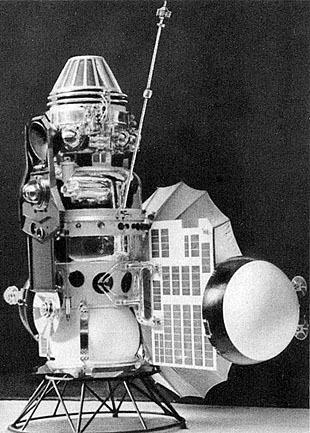
"Venera-3" as you can see from the photos, the stations were very similar.
The data obtained from the "Venus-3 'were used in the creation of the" Venus-4 ". The lander had to work at a temperature of 425 ° C and pressures up to 10 atmospheres. "Venus-4" consisted of orbital module and lander. In the orbital module was all telemetry equipment, and in the descent capsule parachute and sensors, pressure, and gas sensors determine the density of the atmosphere.
In "Venus-4" was used 6-bit telemetry interrogation velocities 1, 4, 16 and 64 bits / s, which could operate in direct transmission mode and in write mode with the subsequent reproduction. To record the TM data in the standby mode of the telemetry system was part of a tape capacity of 150 thousand bits. Information transfer rate of 64 bits per second carried out through the parabolic gain antenna (SHE) diameter ~ 2, 3 meters. Thermal control system circulates the gas in the orbital compartment by a fan and the heat is reset through the radiator, cooler, built-in high gain antenna.
In the radio system lander used the same transmitter as in the orbital module. Telemetry and scientific information delivered directly to the lander to Earth. But given the distance to Venus, and the fact that the transmission of scientific information was conducted through malonapravlennuyu antenna data transmission rate is only 1 bit per second.
Before the start of the lander was sterilized to prevent skidding on Venus microorganisms terrestrial origin.
After 128 days after the start of the October 18, 1967, "Venera-4" has moved closer to the planet. Lander at the entrance of the Venusian atmosphere, which occurred on the night side of the planet near the equator in 1500 km from the morning terminator, experienced overload of 300 units.
The main result of the flight "Venera-4" was the first direct measurements of temperature, density, pressure and chemical composition of the atmosphere of Venus.
Gas analyzers showed predominant content in the Venusian atmosphere of carbon dioxide (~ 90%) and very low content of oxygen and water vapor.
Scientific instruments orbiter "Venera-4" showed no Venus radiation belts, and the magnetic field of the planet appeared 3,000 times weaker than Earth's magnetic field. In addition, using the indicator of UV radiation of the sun was detected hydrogen corona of Venus, containing about 1000 times less hydrogen than the Earth's upper atmosphere. Atomic oxygen is the same indicator was detected.
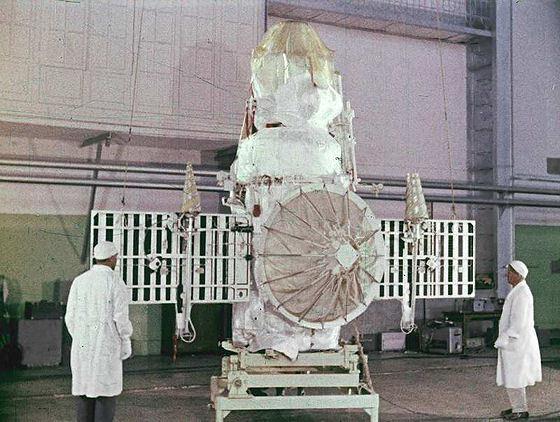
"Venus-4»
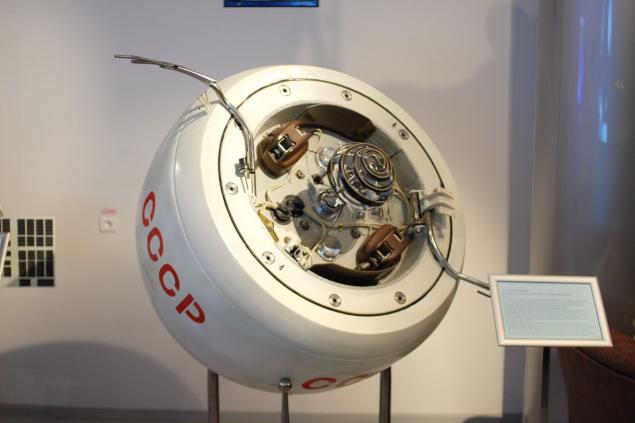
Lander "Venera-4»
Satellites "Venera 5 and 6," just reached Venus, and received data to create a better spacecraft "Venera 7»
Spacecraft "Venera-7" was intended for delivery to the surface of Venus lander.
Unlike previous expeditions, the main goal when starting in 1970, has already put a landing on the planet's surface. Therefore, in the initial data entered and the wind speed at the surface of Venus, which has been calculated as 1, 5 m / s.
Due to the increase of almost 100 kg lander compared with the lander "Venus-5, 6" had to maximally facilitate orbital compartment. Since it was filmed all scientific equipment except for counter space particles COP 18 4M.
But even then the weight of the entire apparatus (1180 kg) was 50 kg more weight "Venus-5, 6", and thus exceeds the capacity of the media "Molniya-M". Payload carrier managed to increase refining tanks booster (he was designated NIV), which made it possible to add 140 kg of fuel.
The main result of the flight "Venera-7" was the first achievement in the world of the surface of the planet Venus. In this unit landed on the night side of the refusal Venery.Iz telemetry switch was received only information about the pressure that is 90 ± 15 atmospheres and the temperature - 475 ° ± 20 ° C.
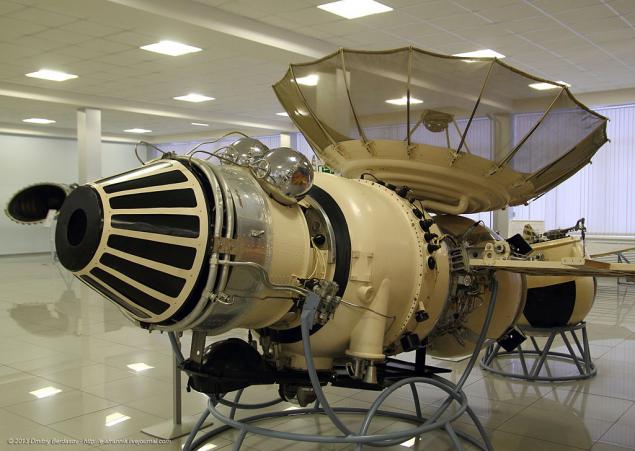
"Venera 7»

Lander "Venera 7»
Spacecraft "Venera-8" is an improved model of the "Venus-7", through the application of the data obtained from the previous satellite. And July 22, 1972 "Venera-8" has reached the planet. When entering the atmosphere of Venus from the station separated lander. During aerodynamic braking in an atmosphere in which the machine is overloaded to 335 g, its speed is reduced from 11 to 6 km / s to 250 m / s, and then at ~ 55 km effect parachute system has been introduced. With the opening of the parachute began the transfer of scientific and service information. After 55 minutes of smooth descent by parachute in the atmosphere of the unit landed on the illuminated side of Venus is 500 km from the morning terminator near the equator, the vertical velocity at the moment of contact was 8, 3 m / s. Radio reception and telemetry information was continued for another 50 minutes after landing. All this time the onboard systems and scientific instruments working normally, that allowed us to obtain complete information not only about the atmosphere of Venus, but also on the conditions on the surface.

"Venera 8" ready to fly.
Next time you start to Venus, were already on the proton, which I'll cover in the next section, as the Proton carrier rocket is a heavy class, its capabilities exceed all before him by a rocket in the USSR, which allows you to display a space much larger payload. Article promises to be very interesting.
Source: habrahabr.ru/post/226959/

Booster "Lightning»

A modified version of the launcher "Molniya-M»
As is known in the solar system has eight planets. This is Mercury, Venus, Earth, Mars, Jupiter, Saturn, Uranus and Neptune. Previously thought planet of the solar system, Pluto now excluded from this "honorable" series. According to the degree of remoteness from the Sun, the Earth is the third. The closest planet to the Sun - it's Mercury, and the most distant - Neptune.
The shortest distance from these planets to Earth following (in millions. Km):
Mercury - 91.6
Venus - 41.4 is the closest planet to Earth.
Mars - 78.3
Jupiter - 628.4
Saturn - 1277.4
Uranus - 2721.4
Neptune - 4347.4
The information we will need later, for understanding, global steps, made the USSR during the space race.
Booster "Lightning" 8K78. The first launch of October 10, 1960. And its modifications "Molniya-M" 8K78M first launch on April 2 1964.
Develop to launch interplanetary spacecraft to Venus and Mars, and then - to run a series of lunar vehicles E-6 and E-6C ("Luna 4" - "Luna-14") has received prominence in connection with the launch of the satellite communications "Lightning" into high orbit.
With the help of these devices has been solved the problem of long-distance telephone and telegraph communications and relay transmission CCTV programming.
Later used to launch satellites Early-warning radar (EWS) "Eye».
It is noteworthy that this booster is one of the most successful. Who started it based missile carriers Union. Separately, you can say about satellites "Moon" which she launched into space. Of the 10 satellites, only 5 have coped with their tasks. I would particularly like to note the "Luna-9" and "Luna 13»
"Luna-9" the world's first soft-landed on the lunar surface in the Ocean of Storms, west of Reiner crater and Marius, at coordinates 64 degrees 22 minutes west longitude and 7 degrees 8 minutes north latitude. Station were held 7 sessions a total duration of more than 8 hours. During these sessions, AMC aired a panoramic image of the lunar surface near the landing site.
"Luna-9" has worked for 7 days and transferred to the ground three-photo panorama of the lunar surface. In addition, the station was equipped with gruntomerom-penetrometer radionuclear densitometer and dynamograph by which conducted the first in the history of instrumental study of the density and strength of the surface layer of lunar soil

"Luna-9»

"Luna-9" from the lander.

Figure descent module "Luna-9" on the background of its orbital module
The rest of the "Luna - 10, 11, 12, 14 'is not landed on our natural satellite, and the measurements made near-moon space.

"Luna-10»
Also on these carrier rockets were launched satellites "Mars" and "Venus". USSR championship vomited again in the US, but now it was a satellite launch to other planets.
Mars 1 - automatic interplanetary station Mars second generation program. One of the three AMC series M-62. The spacecraft was intended for research of Mars-flight trajectory, transmitting information about interplanetary space and the space around Mars. The first spacecraft to fly to Mars - "Mars-1" was created in OKB SP Korolev and launched in 1962, but has not reached the planet.

AMC "Mars-1" model.
"Venus-1" - automatic interplanetary station for investigation of the planet Venus. "Venus-1" was the first spacecraft flown 100 000 km from the planet Venus. At different stages of startup sometimes referred to as "heavy satellite 02" or "Satellite-8". From the station "Venus-1" were transferred to the measurements of solar wind parameters (after the discovery of the solar wind station "Luna-1") and cosmic rays near the Earth, and at 1, 9 million kilometers from Earth. As we know, the Venus 41, 4 million. Km and a distance of 1, 9 million. Km "Venera-1" has done in just 7 days, until the connection is not lost. The reason was quite annoying circumstance. Communication with the satellite was not constant, and on-board automation team, which includes a specified time and at the exit thereof, communication becomes impossible. What happened. Subsequently, scientists have recognized that the costs at a constant connection is not so critical and quite pay off, if you do not disable the connection and not lose in this companion forever. But even in such a short time that the station was in touch with TsUPom been done quite a lot of discoveries and innovations. It was the first apparatus designed for planetary exploration. Technique was first used on the three axes of orientation of the spacecraft by the sun and stars Canopus. For the first time for the transmission of telemetry data was used parabolic antenna.

"Venus-1" the first satellite sent to the nearest planet.
Soon, November 12, 1965, were launched "Venera-2" and 4 days "Venera-3" which was planned to land on Venus. But because of the problems in the control system, and the task was not completed. "Venera-3" was the first spacecraft that reached the surface of another planet and "Venera-2" flew over Venus at a distance of 24,000 km. During the flight to the station "Venus-3" was held a session of 63 (26 with "Venus-2"). Stations already ceased to transmit information on the approach to the planet and on the scientists have not been able to get any data on the nearest neighbor.

"Venus-2»

"Venera-3" as you can see from the photos, the stations were very similar.
The data obtained from the "Venus-3 'were used in the creation of the" Venus-4 ". The lander had to work at a temperature of 425 ° C and pressures up to 10 atmospheres. "Venus-4" consisted of orbital module and lander. In the orbital module was all telemetry equipment, and in the descent capsule parachute and sensors, pressure, and gas sensors determine the density of the atmosphere.
In "Venus-4" was used 6-bit telemetry interrogation velocities 1, 4, 16 and 64 bits / s, which could operate in direct transmission mode and in write mode with the subsequent reproduction. To record the TM data in the standby mode of the telemetry system was part of a tape capacity of 150 thousand bits. Information transfer rate of 64 bits per second carried out through the parabolic gain antenna (SHE) diameter ~ 2, 3 meters. Thermal control system circulates the gas in the orbital compartment by a fan and the heat is reset through the radiator, cooler, built-in high gain antenna.
In the radio system lander used the same transmitter as in the orbital module. Telemetry and scientific information delivered directly to the lander to Earth. But given the distance to Venus, and the fact that the transmission of scientific information was conducted through malonapravlennuyu antenna data transmission rate is only 1 bit per second.
Before the start of the lander was sterilized to prevent skidding on Venus microorganisms terrestrial origin.
After 128 days after the start of the October 18, 1967, "Venera-4" has moved closer to the planet. Lander at the entrance of the Venusian atmosphere, which occurred on the night side of the planet near the equator in 1500 km from the morning terminator, experienced overload of 300 units.
The main result of the flight "Venera-4" was the first direct measurements of temperature, density, pressure and chemical composition of the atmosphere of Venus.
Gas analyzers showed predominant content in the Venusian atmosphere of carbon dioxide (~ 90%) and very low content of oxygen and water vapor.
Scientific instruments orbiter "Venera-4" showed no Venus radiation belts, and the magnetic field of the planet appeared 3,000 times weaker than Earth's magnetic field. In addition, using the indicator of UV radiation of the sun was detected hydrogen corona of Venus, containing about 1000 times less hydrogen than the Earth's upper atmosphere. Atomic oxygen is the same indicator was detected.

"Venus-4»

Lander "Venera-4»
Satellites "Venera 5 and 6," just reached Venus, and received data to create a better spacecraft "Venera 7»
Spacecraft "Venera-7" was intended for delivery to the surface of Venus lander.
Unlike previous expeditions, the main goal when starting in 1970, has already put a landing on the planet's surface. Therefore, in the initial data entered and the wind speed at the surface of Venus, which has been calculated as 1, 5 m / s.
Due to the increase of almost 100 kg lander compared with the lander "Venus-5, 6" had to maximally facilitate orbital compartment. Since it was filmed all scientific equipment except for counter space particles COP 18 4M.
But even then the weight of the entire apparatus (1180 kg) was 50 kg more weight "Venus-5, 6", and thus exceeds the capacity of the media "Molniya-M". Payload carrier managed to increase refining tanks booster (he was designated NIV), which made it possible to add 140 kg of fuel.
The main result of the flight "Venera-7" was the first achievement in the world of the surface of the planet Venus. In this unit landed on the night side of the refusal Venery.Iz telemetry switch was received only information about the pressure that is 90 ± 15 atmospheres and the temperature - 475 ° ± 20 ° C.

"Venera 7»

Lander "Venera 7»
Spacecraft "Venera-8" is an improved model of the "Venus-7", through the application of the data obtained from the previous satellite. And July 22, 1972 "Venera-8" has reached the planet. When entering the atmosphere of Venus from the station separated lander. During aerodynamic braking in an atmosphere in which the machine is overloaded to 335 g, its speed is reduced from 11 to 6 km / s to 250 m / s, and then at ~ 55 km effect parachute system has been introduced. With the opening of the parachute began the transfer of scientific and service information. After 55 minutes of smooth descent by parachute in the atmosphere of the unit landed on the illuminated side of Venus is 500 km from the morning terminator near the equator, the vertical velocity at the moment of contact was 8, 3 m / s. Radio reception and telemetry information was continued for another 50 minutes after landing. All this time the onboard systems and scientific instruments working normally, that allowed us to obtain complete information not only about the atmosphere of Venus, but also on the conditions on the surface.

"Venera 8" ready to fly.
Next time you start to Venus, were already on the proton, which I'll cover in the next section, as the Proton carrier rocket is a heavy class, its capabilities exceed all before him by a rocket in the USSR, which allows you to display a space much larger payload. Article promises to be very interesting.
Source: habrahabr.ru/post/226959/
Tags
See also
300 of the best documentaries to expand consciousness
A regular bus Minsk-Moscow.
Development of the child in 9 months
10 ink spots: how does Rorschach test
Food on board aircraft
The residence of British monarchs (32 photos)
Black Hand or coffin on wheels ... - why, what and why market participants are afraid of commercial real estate.

















